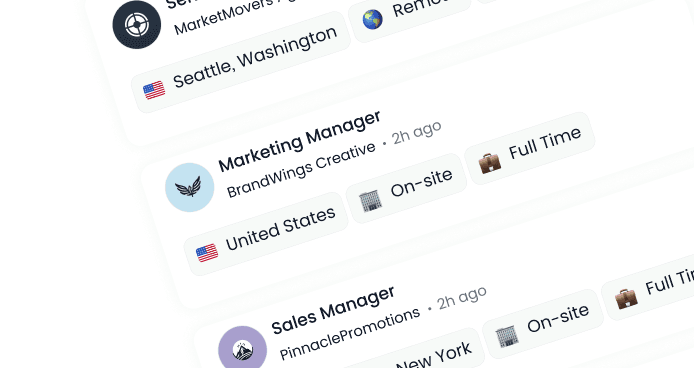AI in Remote Work Hiring: How to Build a Borderless Talent Engine
Published:
October 24, 2025
All
AI Recruitment
Recruiting Tips
Employer Branding
Candidate Experience
Video Interviews
Workforce Planning
Remote hiring just got a whole lot smarter — and the entire world is now your talent pool.
Remote hiring promised global reach… but it also brought time zones, inbox overload, and slower decisions. That’s where AI comes in — not to replace recruiters — but to remove the chaos and help you hire great talent anywhere, faster.
Recruiters adopting AI now are already seeing what’s possible: wider talent pools, streamlined workflows, and more fairness across borders. Here’s how to make it work for you.
Why AI Is the Backbone of Remote Hiring
When your candidates are everywhere, your hiring tools have to work everywhere too. AI helps you get:
Global reach without the admin limitations.
AI expands global talent acquisition by automatically highlighting qualified candidates across markets, languages, and platforms—without adding hours to your search. To elaborate, AI-driven search agents scan multiple channels and recommend candidates you might miss with keyword search alone.
They can guess relevant skills, detect profile key markers, and highlight people in under-represented regions, supporting cross-border recruitment with less friction. It helps you map where the skills live, not just where your HQ sits.
Speed where it matters.
From parsing profiles to screening inbound applications, AI reduces manual sorting and creates standardized shortlists. That speed is critical in remote contexts where excellent candidates evaluate multiple offers simultaneously.
Personalization at scale.
Smart prompts and adaptive templates let you tailor outreach, assessments, and follow-ups without sounding robotic. Done well, this nurtures a more human experience—even as you automate repetitive tasks.
Inclusivity by design.
With structured scoring rubrics, consistent virtual interviews, and transparent criteria, AI can reduce random bias and make distributed hiring fairer. Layer guardrails (human review, job-relevant questions, audit logs) to keep outcomes accountable.
Besides the above mentioned points, AI when combined with recruitment platforms such as DigitalHire and others can help streamline the basic processes when it comes to hiring remotely.
The Core Workflows AI Improves
Virtual screening that respects time zones.
Asynchronous, pre-recorded virtual interviews let candidates respond when it suits their time zone while giving recruiters structured clips to review. AI helps with question banks, auto-transcription, and summary highlights—so you can compare answers consistently and move stronger candidates ahead quickly.
Better indicators of remote-work success.
AI can flag patterns linked to remote success—self-management, communication clarity, overlap hours—by analyzing structured responses, work samples, and collaboration histories (when available). This doesn't replace judgment; it gives you cleaner signal earlier, improving remote workforce management decisions.
We have covered the advantages and benefits of using AI based tools to promote remote hiring if you are looking to implement such solutions, we’ll cover the process to follow next.
Your Remote Hiring Playbook (A Practical Guide)
When it comes to implementing processes for remote hiring that are fast, fair and scalable, we have set up an example step-by-step workflow. However, by no means is this exhaustive and there can be other ways to go about it:
Define what success looks like in remote roles.
Clarify must-have competencies: async communication, autonomy, problem-solving, and overlap needs. Tie each to observable evidence (work samples, scenario answers).
Standardize questions and scoring.
Build role-specific questions and structure rules for virtual interviews. Use AI for drafting but lock criteria with human oversight.
Automate the repetitive work, not the judgment.
Let AI handle parsing, deduping, shortlisting, and scheduling. Keep humans on calibration, positive candidate touchpoints, and final decisions.
Track what matters.
Track time-to-shortlist, first-response time, offer-accept rate, and 90-day success. Segment by locale to spot friction in cross-border recruitment.
Mitigate risks upfront.
Add clear consent screens, bias checks, and identity verification. Document what your models consider and create a review path (appeals, human override).
Improve continuously with real feedback.
Have recruiters mark AI recommendations as "useful/not useful" to improve matching. Invite candidates to rate interview clarity and fairness—then adjust prompts and rubrics accordingly.
Small AI Tweaks That Make Global Hiring Work
Time zones.
Use AI to propose interview slots that maximize overlap and candidate convenience. Async virtual interviews reduce churn for regions with minimal overlap.
Localization.
Automate language support for job posts and candidate communication; keep assessment criteria language-neutral and job-relevant. Add human QA for sensitive phrasing.
Regulations.
AI can flag right-to-work, contractor vs. employee considerations, and region-specific compliance checkpoints. Final calls should remain with your HR/legal team.
Culture add indicators.
Train interview prompts to test collaboration styles and communication in distributed teams (e.g., written clarity, ownership, proactive updates). This aligns hiring with the realities of remote delivery.
The above are manual tweaks to consider when utilizing AI, how you implement them or if you do at all are based on a company’s individual objectives. Take for example, language support, if you are hiring a remote software developer, then verbal communication might not take as much precedence as his software coding skills. The fact that the person can understand the instructions and implement them correctly would be the focus.
In Conclusion
Remote work is borderless. Your hiring should be too. AI in remote work hiring makes it practical: wider reach, faster cycles, and more consistent decisions—without losing the human touch. If you're ready to see what a video-first, AI-enabled workflow looks like in practice, explore DigitalHire a modern platform that brings the benefit of an AI-powered hiring platform, digital recruitment tools, and virtual interviews together in one place.
FAQs
Will AI replace recruiters in remote hiring?
No. AI excels at search, summarization, and logistics. Recruiters still lead on stakeholder alignment, offer strategy, and the human trust that closes great candidates.
Which roles are most "remote-safe"?
Jobs with complex stakeholder work, domain judgment, or hands-on collaboration usually stay hybrid/remote-friendly; routine, highly automatable tasks are more likely to shift in scope (see UCLA Anderson review above).
How do I keep virtual interviews fair?
Use job-relevant, structured prompts; provide practice questions; disclose how responses are assessed; and keep a human reviewer in the loop.
What's the quickest win to start?
Standardize your top three role templates (Job Description, question bank, scoring), then pilot async virtual interviews in one geography. Measure time-to-shortlist and candidate drop-off before scaling.
FREE JOB POST
Looking to fill a position quickly? Post your job for free and reach top talent today!




